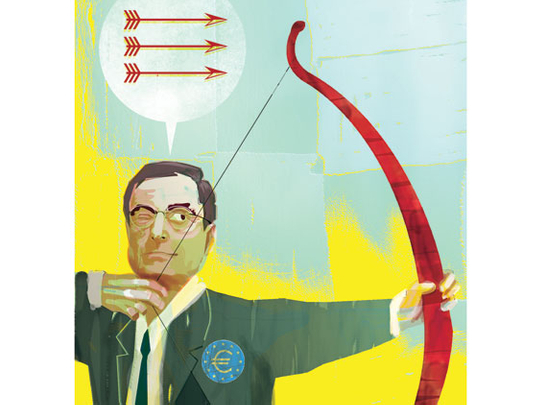
Two years ago, Shinzo Abe’s election as Japan’s prime minister led to the advent of “Abenomics”, a three-part plan to rescue the economy from a treadmill of stagnation and deflation.
Abenomics’ three components — or “arrows” — comprise massive monetary stimulus in the form of quantitative and qualitative easing (QQE), including more credit for the private sector; a short-term fiscal stimulus, followed by consolidation to reduce deficits and make public debt sustainable; and structural reforms to strengthen the supply side and potential growth.
It now appears — based on European Central Bank President Mario Draghi’s recent Jackson Hole speech — that the ECB has a similar plan in store for the Eurozone. The first element of “Draghinomics” is an acceleration of the structural reforms needed to boost the Eurozone’s potential output growth.
Progress on such vital reforms has been disappointing, with more effort made in some countries (Spain and Ireland, for example) and less in others (Italy and France, to cite just two).
But Draghi now recognises that the Eurozone’s slow, uneven, and anaemic recovery reflects not only structural problems, but also cyclical factors that depend more on aggregate demand than on aggregate supply constraints. Thus, measures to increase demand are also necessary.
Here, then, is Draghinomics’ second arrow: to reduce the drag on growth from fiscal consolidation while maintaining lower deficits and greater debt sustainability. There is some flexibility in how fast the fiscal target can be achieved, especially now that a lot of front-loaded austerity has occurred and markets are less nervous about the sustainability of public debt.
Moreover, while the Eurozone periphery may need more consolidation, parts of the core — say, Germany — could pursue a temporary fiscal expansion (lower taxes and more public investment) to stimulate domestic demand and growth. And a Eurozone wide infrastructure-investment programme could boost demand while reducing supply-side bottlenecks.
The third element of Draghinomics — similar to the QQE of Abenomics — will be quantitative and credit easing in the form of purchases of public bonds and measures to boost private-sector credit growth. Credit easing will start soon with targeted long-term refinancing operations (which provide subsidised liquidity to Eurozone banks in exchange for faster growth in lending to the private sector). When regulatory constraints are overcome, the ECB will also begin purchasing private assets (essentially securitised bundles of banks’ new loans).
Now Draghi has signalled that, with the Eurozone one or two shocks away from deflation, the inflation outlook may soon justify quantitative easing (QE) like that conducted by the US Federal Reserve, the Bank of Japan, and the Bank of England: outright large-scale purchases of Eurozone members’ sovereign bonds. Indeed, it is likely that QE will begin by early 2015.
Quantitative and credit easing could affect the outlook for Eurozone inflation and growth through several transmission channels. Shorter- and longer-term bond yields in core and periphery countries — and spreads in the periphery — may decline further, lowering the cost of capital for the public and private sectors.
The value of the euro may fall, boosting competitiveness and net exports. Eurozone stock markets could rise, leading to positive wealth effects. Indeed, as the likelihood of QE has increased over this year, asset prices have already moved upward, as predicted.
These changes in asset prices — together with measures that increase private-sector credit growth — can boost aggregate demand and increase inflation expectations. One should also not discount the effect on “animal spirits” — consumer, business, and investor confidence — that a credible commitment by the ECB to deal with slow growth and low inflation may trigger.
Some more hawkish ECB officials worry that QE will lead to moral hazard by weakening governments’ commitment to austerity and structural reforms. But in a situation of near-deflation and near-recession, the ECB should do whatever is necessary, regardless of these risks.
Moreover, QE may actually reduce moral hazard. If QE and looser short-term fiscal policies boost demand, growth, and employment, governments may be more likely to implement politically painful structural reforms and long-term fiscal consolidation. Indeed, the social and political backlash against austerity and reform is stronger when there is no income or job growth.
Draghi correctly points out that QE would be ineffective unless governments implement faster supply side structural reforms and the right balance of short-term fiscal flexibility and medium-term austerity. In Japan, though QQE and short-term fiscal stimulus boosted growth and inflation in the short run, slow progress on the third arrow of structural reforms, along with the effects of the current fiscal consolidation, are now taking a toll on growth.
As in Japan, all three arrows of Draghinomics must be launched to ensure that the Eurozone gradually returns to competitiveness, growth, job creation, and medium-term debt sustainability in the private and public sectors. By the end of this year, it is to be hoped, the ECB will start to do its part by implementing quantitative and credit easing.
— The writer is Chairman of Roubini Global Economics and a professor at NYU’s Stern School of Business.












